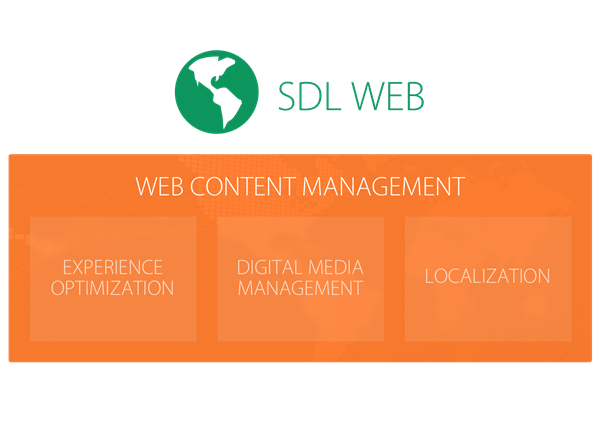“The future depends on what we do today.”
— Mahatma Gandhi
The last post described the SDL Tridion name change to SDL Web 8. This post looks at product vision, focus, and feature comparisons.
Strategic Roadmap: Where are we heading?
The future of SDL Web depends on what we’ve accomplished in the past and what we’re focusing on today. The current SDL Web roadmap has four parts:
- Aggregate (last two years)
- Accelerate (this year and next)
- Automate (2016-2017, possibly part of or input into SDL Web 9)
- Predict and Understand (in the next three years or so)
In the last few releases of SDL Tridion we focused on aggregation where CMS users have gained more control over items, even from other systems, in the context of the Content Manager Explorer. Also we unified the user interfaces across all SDL products and now provide easy access to other solutions within the SDL Customer Experience Cloud directly from within the web content editor’s environment.
SDL Web features under the aggregation theme included:
- Unified user interface
- Bundles
- Batch Processor
- External Content Libraries
The focus is now on acceleration. With over a decade of implementation experience and a mature, open developer community, SDL has released the Digital Experience Accelerator (DXA), an open source standard reference implementation that can deliver up to 70% of a standard project implementation.
This aggregation and acceleration will help us focus on more automation and predictive features in the next few years. This diagram shows the current SDL Web strategic roadmap.
As with any technical product roadmap, the details and deliverables must adjust with the market. In the end, we need to deliver solutions that make it easier to orchestrate a contextual experience based on practical insights and analytics.
SDL Web includes four main parts that help Marketing Operations, IT, and the business:
- Web Content Management (the majority of what we used to call SDL Tridion)
- Experience Optimization (SDL SmartTarget, Mobile, and the Ambient Data Framework)
- Digital Media Management (SDL Media Manager)
- Localization (Translation Management)
Focus Overview
Next to the “Acceleration” focus in SDL Web 8 we have also put a lot of effort into cloud enablement and reducing the total cost of ownership for our clients. The main new capabilities are listed below:
- Acceleration
- More flexible BluePrinting model with adjustable hierarchy positioning – promote and demote items (move up or down)
- Instant Site, a wizard driven way for business users to launch brand new websites without any IT handholding
- Digital Experience Accelerator - .NET and Java versions, and additional “plug-in” modules such as ECL, Media Manager, SmartTarget, and Search (with both Solr and AWS CloudSearch support) to dramatically speed up projects
- Cloud & Deployment
- Extending PaaS models and native support for Cloud
- Greater support for Cloud 3rd databases (SQL Azure, AWS RDS)
- Topology Manager, a brand new addition to SDL Web 8 that
- drastically simplifies delivery server configuration management (cloud & on-premise)
- provides predefined delivery server topologies from which business users can select. Publishing now happens “by purpose” (Staging, Live) rather than to a specific target
- Total Cost of Ownership
- Backwards compatibility (same CD API syntax) for the new Content Delivery Services
- Self-running and self-contained REST-based Content Interaction Services that fully decouple the WebApp from the SDL Web delivery stack to
- Provide separation of concerns
- Speed up development
- Radically simplify upgrades
- Enable centralized configuration
- Enable Faster, automated installation and setup time
- Provide “Platform” support at framework level (.NET, Java SE) meaning you can use any Application Server as long as the correct .Net / Java version is supported
- Cloud DB Support (SQL Azure, AWS RDS)
Feature Comparison Matrix: Functionality
The following tables highlight expected functionality for Web 8 as compared to the previous two major versions (final details are subject to change).
Legend
|
Icon |
Meaning |
|
not included
|
|
|
limited support for this feature
|
|
|
included feature in this release
|
|
Feature |
2011 |
2013 |
Web 8 (2015 Q4) |
|
Ability to browse to page from CM Explorer |
|
||
|
Content Experiments |
|
||
|
Metadata support for Translation Jobs |
|
|
|
|
Site Launch Wizard |
|
||
|
Business Process Types (Topology selection) |
|
|
|
|
Centralized Configuration (CD) |
|
|
|
|
Content Bundles / Multi-item workflow |
|
||
|
Contextual/Footprint Preview |
|||
|
Experience Manager |
|||
|
Built-In Device Preview |
|||
|
External Content Library |
Feature Comparison Matrix: Technical
SDL Web 8 introduces features that accelerate technical aspects as well.
Legend
|
Icon |
Meaning |
|
not included
|
|
|
limited support for this feature
|
|
|
included feature in this release
|
|
Feature |
2011 |
2013 |
Web 8 (2015 Q4) |
|
Cloud DB Support: Microsoft, Amazon |
|
||
|
Site Topology Management (CD Discovery service) |
|
|
|
|
Content Delivery Microservice architecture |
|
|
|
|
Public Artifact Repository |
|
|
|
|
Digital Experience Accelerator (Java &.NET) |
|
||
|
Workflow Performance Improvements |
|
||
|
Latest platform support (DB, OS, etc.) |
|||
|
Translation Manager Event System |
|
||
|
Bulk load of items via API |
|
|
|
|
External Content Library API |
|
||
|
PowerShell scripts for DB |
|
In the next post, we've asked UX Designer Nikki Veldhuis to share some screenshots and prototypes for what we're planning in SDL Web 8.
Editor's notes:
Thanks again to Nikki with UX for the updated graphics, which are nicer than the originals from my previous presentations, and to Nuno Linhares, Arjen van den Akker, and the rest of the team for letting me share roadmap and behind-the-scenes details.

 Translate
Translate

